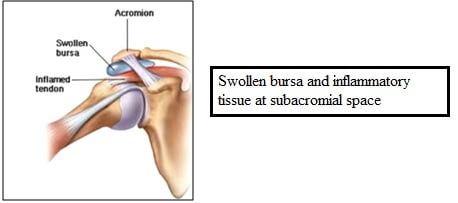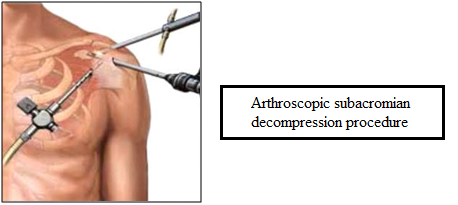Arthroscopic Subacromial Decompression
Shoulder is a complex joint having important role during pulling, pushing and lifted activities of the arm.
Arthroscopic Subacromial Decompression is a pinhole surgery usually done in cases of Subacromial Impingement. Subacromial impingement is a condition in which patient has pain in lifting arm. All overhead activities are restricted due to pain.
One can also develop symptoms of Subacromial impingement after trauma or due to age related changes. This condition also develops in patients with inborn malformation of the shoulder joint.
Arthroscopic Subacromial Decompression is done in such patients where medication and physiotherapy do not provide much relief. Arthroscopic Subacromial Decompression involves removing tissue from the front of the shoulder joint (Subacromian Space). Subacromial space is a space located below the outcropping of the bone on the shoulder blade also known as acromian process.


During this procedure, all the inflammatory tissue and the degenerative bony spurs developed due to aging or chronic wear and tear of joint is removed.
FAQs: Arthroscopic Subacromial Decompression
Arthroscopic Subacromial Decompression is a minimally invasive surgical procedure used to relieve pain and impingement in the shoulder by removing inflamed or damaged tissue and creating more space in the subacromial area. This helps in reducing pressure on the tendons and muscles, allowing for better shoulder movement.
This procedure is usually recommended for individuals suffering from shoulder impingement syndrome or rotator cuff problems that have not responded to non-surgical treatments like physical therapy, medication, or steroid injections. It can help reduce pain, improve range of motion, and restore normal shoulder function.
Arthroscopic Subacromial Decompression is performed using a small camera (arthroscope) inserted through tiny incisions in the shoulder. The surgeon uses specialized instruments to remove or trim inflamed tissue, bone spurs, or thickened ligaments in the subacromial space.
- Minimally invasive
- Shorter recovery time compared to open surgery
- Reduced post-operative pain and scarring
- Improved shoulder mobility and function
- Faster return to daily activities and work
The procedure typically takes about 1 to 1.5 hours, depending on the extent of the damage and the specific surgical needs of the patient.
Recovery after Arthroscopic Subacromial Decompression usually involves a period of rest, followed by a rehabilitation program. You will likely need to wear a sling for a few days, and physical therapy will begin within a week to help regain mobility and strength. Full recovery can take 3-6 months, depending on the individual case.
Pain levels vary from patient to patient, but arthroscopic surgery generally causes less pain compared to open surgery. Pain is typically managed with medications and cold therapy. Over-the-counter pain relievers and prescription medications may be used as needed during recovery.
Like any surgical procedure, Arthroscopic Subacromial Decompression carries certain risks, such as:
- Infection
- Bleeding
- Stiffness in the shoulder
- Incomplete pain relief
- Damage to surrounding nerves or tissues However, these complications are rare and the procedure is generally considered safe.
Depending on your job and the extent of your surgery, most patients can return to light activities and work within 2-4 weeks. For more physically demanding jobs or sports, it may take 2-3 months, and full recovery can take up to 6 months.
Yes, physical therapy is a crucial part of the recovery process after this surgery. A structured rehab program helps restore full function to the shoulder and improves range of motion. You will work with your physical therapist on exercises tailored to your recovery goals.
- Follow your surgeon’s instructions closely
- Attend all physical therapy sessions
- Avoid strenuous activities until cleared by your doctor
- Maintain a healthy diet and stay hydrated
- Take prescribed medications and use cold therapy to reduce swelling


